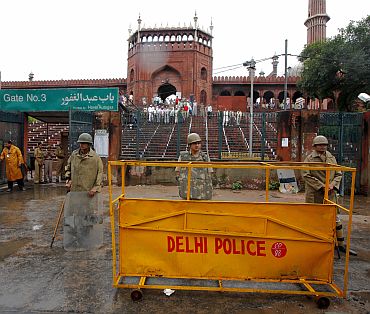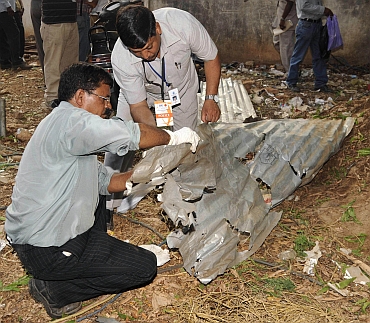Photographs: Reuters
The Jama Masjid firing rocked Delhi last September days before the Commonwealth Games. Two months later, a two-year-old was killed and 25 injured in an explosion at the Dashashwamedh Ghat in Varanasi. And the latest in the list of terror strikes is the 13/7 serial bombings in Mumbai that left 27 dead.
What's common among the three attacks? These strikes may have caused less destruction as compared to terror attacks of the past, but they have left security agencies groping in the dark. They continue to be unsolved mysteries.
The recent attacks paint a scary picture -- the threat from terrorism is ever growing and security agencies are finding it more and more difficult to get to the bottom of it all.
According to a security expert, this is exactly what the Pakistan-sponsored terrorist groups want. Cases of terror could be solved as long as the perpetrators were part of an organised syndicate, which is no longer is the case, said a counter-terror expert....
Regrouping of SIMI, IM put on hold
Image: Onlookers stand at the site of a blast in Varanasi on TuesdayPhotographs: Reuters
However, the Jama Masjid firing, the Varanasi and 13/7 Mumbai attacks were chaotic and conventional methods were not used by terrorists to carry out the strikes.
Today, Intelligence Bureau officials point out that fringe elements belonging to SIMI were behind the attacks. "Although we have not been able to come to a definitive conclusion, we can say with confidence that some stray elements are responsible," said an IB source.
There have been sporadic attempts to regroup outfits such as the IM and SIMI in some parts of the country. However, the message from Pakistan is clear -- the regrouping will have to wait. What's more important is to spread terror and more essentially to ensure that Pakistan remains out of the trail.
Recent terror strikes are revenge attacks
Image: Members of the bomb squad and Mumbai police at Zaveri BazaarWhat they also realised that some youths were equipped to continue the 'mission' without any aid from established modules in India or Pakistan. Hence, the handlers across the border decided to step back too and made no further attempts to regroup outfits, which were already under the scanner of security agencies.
The IB said the latest trend is that a group of four to five youths join hands and execute attacks. They are neither associated with SIMI or the IM and these outfits are clueless about those behind these strikes.
The recent attacks have been acts of revenge. The arrests of former SIMI general secretary Safdar Nagori and suspects in the Batla House encounter egg these youths on, said investigators.
Following the recent terror strikes, the IB has checked all communication to Pakistan, but in vain. The interrogation of various other SIMI and IM operatives has also yielded no results.Self-motivated operatives, a growing threat
Image: Forensic experts inspect the site of a bomb blast in BengaluruPhotographs: Reuters
He managed to raise funds through a Gulf contact and with the help of a couple of labourers carried out the Bengaluru blasts. No one from the SIMI or the IM was aware of these attacks and Nasir soon became an inspiration for the young, who wanted to take to 'jihad'.
There may be a split in terror groups, but this is no good news, say those probing the strikes. A few like-minded youths getting together and coordinating attacks is more dangerous. The attacks may not be planned and may not be very effective in nature, but it continues to be a grave threat to security as they can strike any time.
But what has triggered these youth to take to terror? The Indian agencies can blame themselves to a large extent. The lack of proper investigation, which led to the arrests of innocent youth and men, has created fury among such groups. And this was exactly the motive of the Lashkar-e-Tayiba. They appear to have succeeded in giving birth to elements, which can create a state of complete chaos through their uncoordinated efforts.





article